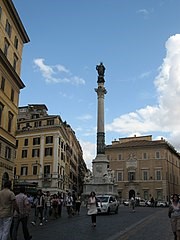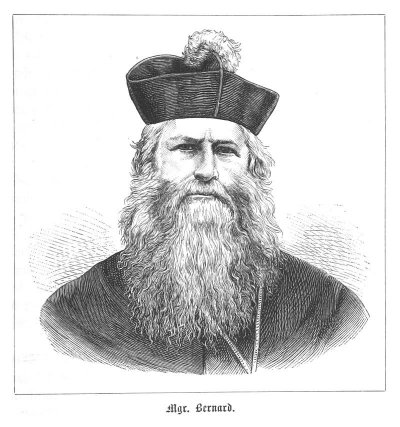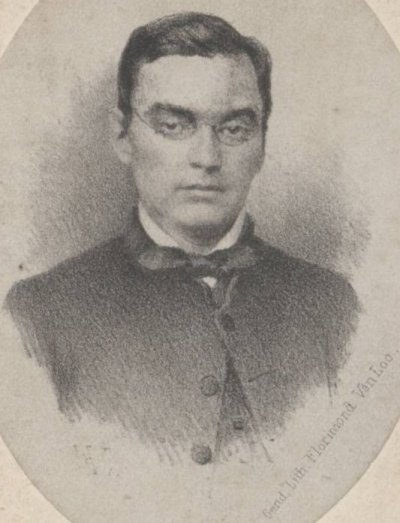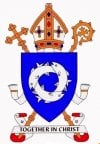North Pole Mission Clergy

Rev Stephen Djunkowsky dates the origin of the North Pole Mission to 8th December 1854, the day of the proclamation in Rome of the dogma of the Immaculate Conception. The new prefecture apostolic was erected by Pope Pius IX exactly one year later, with Djunkowsky as Prefect Apostolic. The first six missionaries were recruited in 1856. The following is a handlist of clergy who worked on the North Pole Mission between 1857 and 1869. It is based primarily on information from the contemporary reports on the progress of the mission, supplemented by information from lists in the Scottish Catholic Directory. The list is not complete: Rev Bernard Bernard, second Prefect Apostolic, wrote in 1865 that in the Mission's first eight years it had lost more members than it currently numbered.
The clergy were split between the six principal missions (Arctic Norway and Lapland, Iceland, Faroe Islands, Caithness with Orkney, and Shetland) and most stations had only one or two resident priests. The Mission was always understaffed. We have lists of the numbers of clergy in the reports published in Belgium: 1856, four priests; 1862, eight priests; 1869, thirteen priests. There were also a number of seminarians. This list is presented in the approximate order the priests joined the North Pole Mission.
PAUL MARIE ETIENNE de DJUNKOWSKY (1821-1870).
Djunkowsky used the French form of his name (often Pere Etienne de Djunkovskoy) but in his native Russia was (Baron) Stepan Stepanovich Djunkowsky. He was born near St Petersburg on 22nd February 1821. The Djunkowsky family were Russian but of Mongol heritage; his mother was Dutch.
In 1845, at the age of 24, Djunkowsky left Russia to join the Jesuit novitiate in Paris. He was one of a group of young Russian nobles who had followed Prince Ivan Gagarin to the west in the hope of bringing about unification of the Russian Orthodox and Catholic churches. In doing so they forfeited their lands by becoming Catholic and faced exile in Siberia if they returned to their native land. Djunkowsky left the Jesuits before ordination and was ordained in Paris as a secular priest in 1852.
He travelled to Rome in 1854 for the proclamation of the Dogma of the Immaculate Conception and was there recruited as the Prefect Apostolic (equivalent in authority to a bishop, but without the power to ordain priests) of the new North Pole Mission. Within months he had moved to Arctic Norway.
We have no photographs of him but a contemporary account describes him as a stocky man, with a "barbarian" look, deep-set eyes, wide nostrils, large mouth and prominent cheek bones. He impressed acquaintances by his gift of languages (he spoke at least five), and his connections with Pope Pius IX and the Academie Francaise.
Djunkowsky established his first base at Altengaard in Arctic Norway but later moved the mission's headquarters to Wick in Northern Scotland. He established a relationship with the Bishops Conference of Belgium, who were to become one of the major supporters of the North Pole Mission, and established an administrative base in Antwerp (c.1857-59). He was housed and financially supported by the Antwerp sugar magnate J. Dewyndt-Aerts.
He pleaded for the incorporation of Orkney and Shetland into his Mission and made his first visit to Shetland on 30th September 1860, taking up residence at the Zetland Hotel in Lerwick (now the Shetland Times Bookshop), where he celebrated the first Mass in Shetland since the Reformation. Within the space of a couple of weeks he had set up the framework of the Shetland Mission and transferred the young Belgian priest, Fr Theophilus Verstraeten, from the Faeroe Islands to be the resident priest in this new mission station.
Djunkowsky suffered a breakdown in health and left the North Pole Mission in September 1861. He was briefly excommunicated by Rome after marrying an Anglican Englishwoman but the marriage did not last and he was reconciled with the Church. He lived in Germany for a while, engaged in literary projects, bur reconverted to Russian Orthodoxy in order to recover his estates in Russia. He died there, aged 49, on 25th March 1870.
ABBE BERNARD BERNARD (1821-1895)

Bernard was born in France on 21st July 1821. His birthplace was the village of Mogues in the Ardennes, close to the border with Belgium. He studied in Rome and was ordained priest in Rheims by Archbishop Thomas-Marie-Joseph Gousset on 5th July 1846. He spent ten years as a diocesan priest in the Ardennes before being recruited to the North Pole Mission at the suggestion of his bishop, who had a great respect for Djunkowsky.
He travelled with Djunkowsky to Altengaard in 1856 and was present at the opening of the mission to Arctic Norway, but within a year had been sent by Djunkowsky to Iceland to begin a mission station there. He returned to France in 1858-59 on a fund-raising appeal and by then was being described by the Prefect Apostolic as his Vicar General. He paid his first visit to Shetland on 7th October 1860 and was the priest who received Mary Nicolson into the Church at Quiensetter, Delting.
After Djunkowsky's abrupt departure from the Mission, Bernard was appointed the second Prefect Apostolic of the North Pole Mission and took up residence in Wick. In 1866, with the approval of Propaganda Fidei, he transferred the headquarters of his mission to Copenhagen, which had better communications with the Danish arctic territories. Three years later the North Pole Mission was dissolved and Bernard was appointed Prefect Apostolic of Norway and Lapland with his residence in Trondheim.
While in Norway, Bernard joined the missionary order of Our Lady of La Salette, a new order whose priests were assisting him in the running of the Norwegian Mission. When he resigned as Prefect Apostolic, in 1887, he returned to France and was given charge of the Shrine of Notre Dame de l'Hermitage, near Noiretable (about 100 km west of Lyons). He died there on 28th October 1895. He is buried at the shrine. Like Djunkowsky, he was 39 when he first arrived in Shetland in 1860.
GEORG BAUER
Bauer was a Bavarian priest from the diocese of Ratisbon. He had been with Djunkowsky at the opening of the Norwegian mission at Altengaard, but in 1857 he took charge of a new mission in the Faroe islands. He was accompanied by an Italian priest, Luigi Mussa, who soon afterwards returned to Italy. Fr Theophilus Verstraten was sent to assist Bauer from 1859 to 1860, but for most of the period of the North Pole Mission, Bauer was alone. In 1869 he was described by Bernard Bernard as vice-Prefect of the North Pole Mission. Bauer left the Faroes in 1872 and was not replaced.
A. BOLLER
Boller was also Bavarian, from the diocese of Wurzburg. He was described as superior of the Lapland Mission in 1859 and listed in the 1865 Scottish Catholic Directory as still resident in Tromso, Norway.
JEAN-BAPTIST BAUDOIN (1831-1875)
Baudoin was from the diocese of Rheims in France. Djunkowsky sent him to Iceland in the spring of 1858 and he was assisted by Bernard Bernard, They were the first Catholic priests to minister in Iceland since the Reformation. Bernard left in 1862 but Baudoin persevered in the Iceland mission until 1875. In the 1862 NPM list he appears as "A. Baudoin", perhaps in confusion with the name of A. Boller.
ELIAS MAESFRANCX (1819-1892)
Maesfrancx was Belgian, from the diocese of Ghent. He had a brother who (in 1859) was parish priest of Peteghem-Deynze, near Ghent. Maesfrancx arrived in Norwegian Lapland before October 1859 and was listed as Apostolic Missioner and Parish Priest of Alten-Talvig in Lapland (June 1860). He was still resident in Altengaard in 1865 but moved to Trondheim in 1866 and thence to the United States. Bernard announced in the 1869 report that Maesfrancx was taking some leave of absence because his health could no longer cope with the hard climate of Lapland, but he remained attached to the North Pole Mission and would seek occasion to return. In 1870-72 he was again in Trondheim before going back to Belgium. In 1875 he transferred to the diocese of Detroit, Michigan, in the UNited States and served in St Mary's Church New Baltimore, and in St Charles' Church Newport where he remained until at least 1879. Some time later he returned to Europe and was living in retirement in Lourdes. He died in Belgium in 1892.
THEOPHILUS MARIE VERSTRAETEN (1832-1871)

Verstraeten was born in Bottelare, Belgium, on 27th December 1832. He was ordained in Ghent on 18th December 1858 and had presumably been recruited for the North Pole Mission while at seminary. He was sent to Copenhagen to learn Danish and then on 14th July 1859, seven months after ordination, was assigned to the Faeroe Islands where he assisted Fr Georg Bauer. He attracted donations for the Faeroe Mission from Belgium and these doubled in the two years from 1857-59. Fr Verstraeten spoke no German and was still imperfect in Danish, so he and Bauer communicated in Latin. From the Faeroes he was summoned to take over the new mission in Shetland (arriving on 7th October 1860) and he remained as resident priest in Lerwick for eleven years until his death from smallpox, contracted from a Belgian fisherman to whom he had administered the Last Rites, on 30th May 1871. Although based in Shetland, he assisted elsewhere in Northern Scotland and in the Wick register described himself as "the missionary in Caithness, Orkney and Shetland". He was buried in Bottelare on 9th June 1871. Fr Verstraten was 27 when he came to Shetland and 38 when he died.
S. MORIGA
From the diocese of Rome. He left the North Pole Mission in April 1863 on medical advice, because of the effect of the climate on his health. He returned to Italy.



